Comparative Analysis: Exploring IFRS and GAAP Accounting Standards
VerifiedAdded on 2023/06/13
|6
|1352
|263
Report
AI Summary
This report provides a detailed comparison between International Financial Reporting Standards (IFRS) and Generally Accepted Accounting Principles (GAAP), focusing on their objectives, similarities, and areas of divergence. IFRS aims to establish a universal language for financial reporting, ensuring transparency and comparability across international companies, while GAAP provides specific guidelines for US-based companies. The report highlights differences in financial statement presentation, recognition of accounting elements, measurement of accounting elements (such as inventory valuation), and disclosures, including the treatment of extraordinary items. Despite these differences, both IFRS and GAAP serve as guiding principles for financial reporting, promoting reliability, transparency, and comparability. The report references several studies to support its analysis of the key distinctions and commonalities between these two major accounting standards. Desklib provides more resources for students.
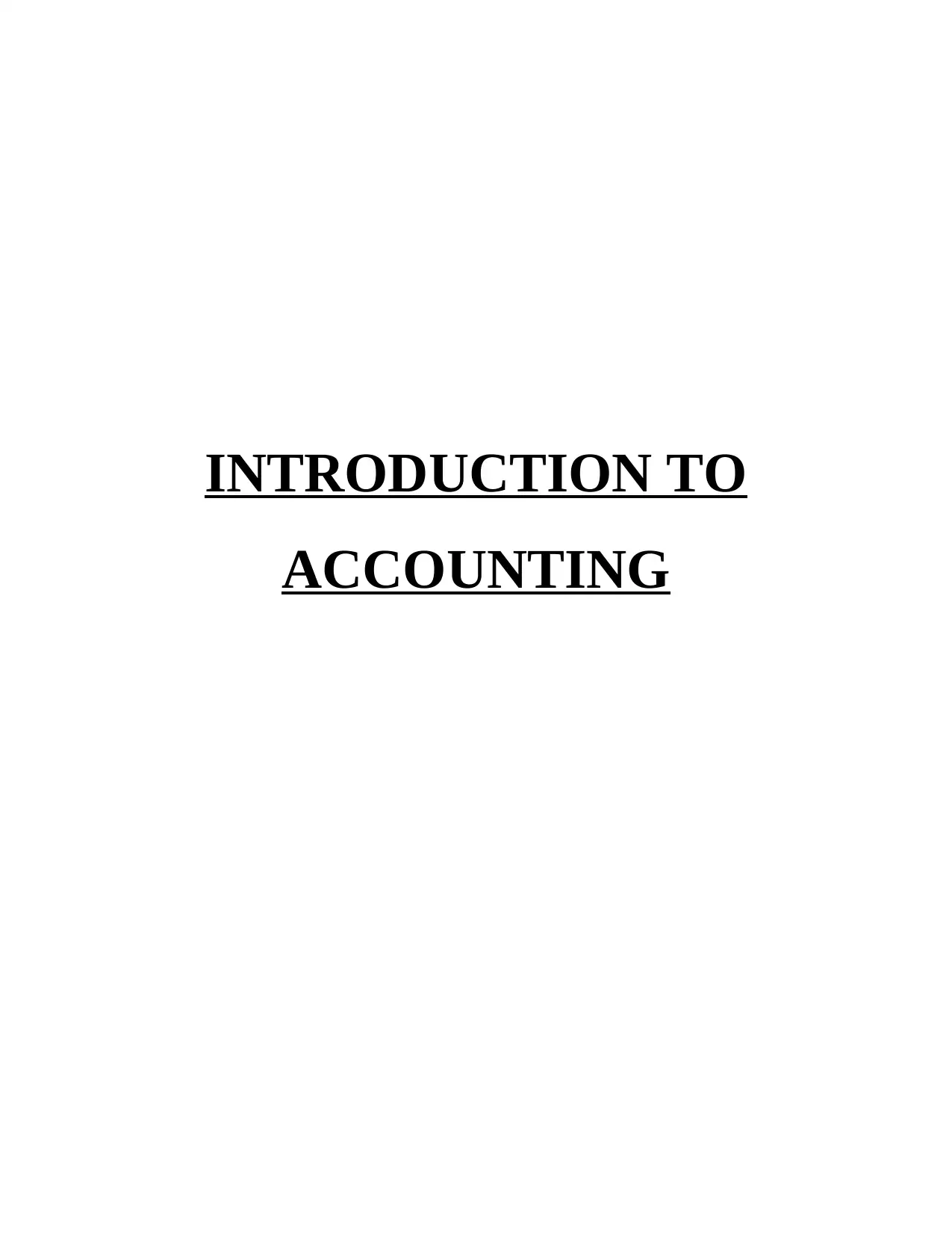
INTRODUCTION TO
ACCOUNTING
ACCOUNTING
Paraphrase This Document
Need a fresh take? Get an instant paraphrase of this document with our AI Paraphraser
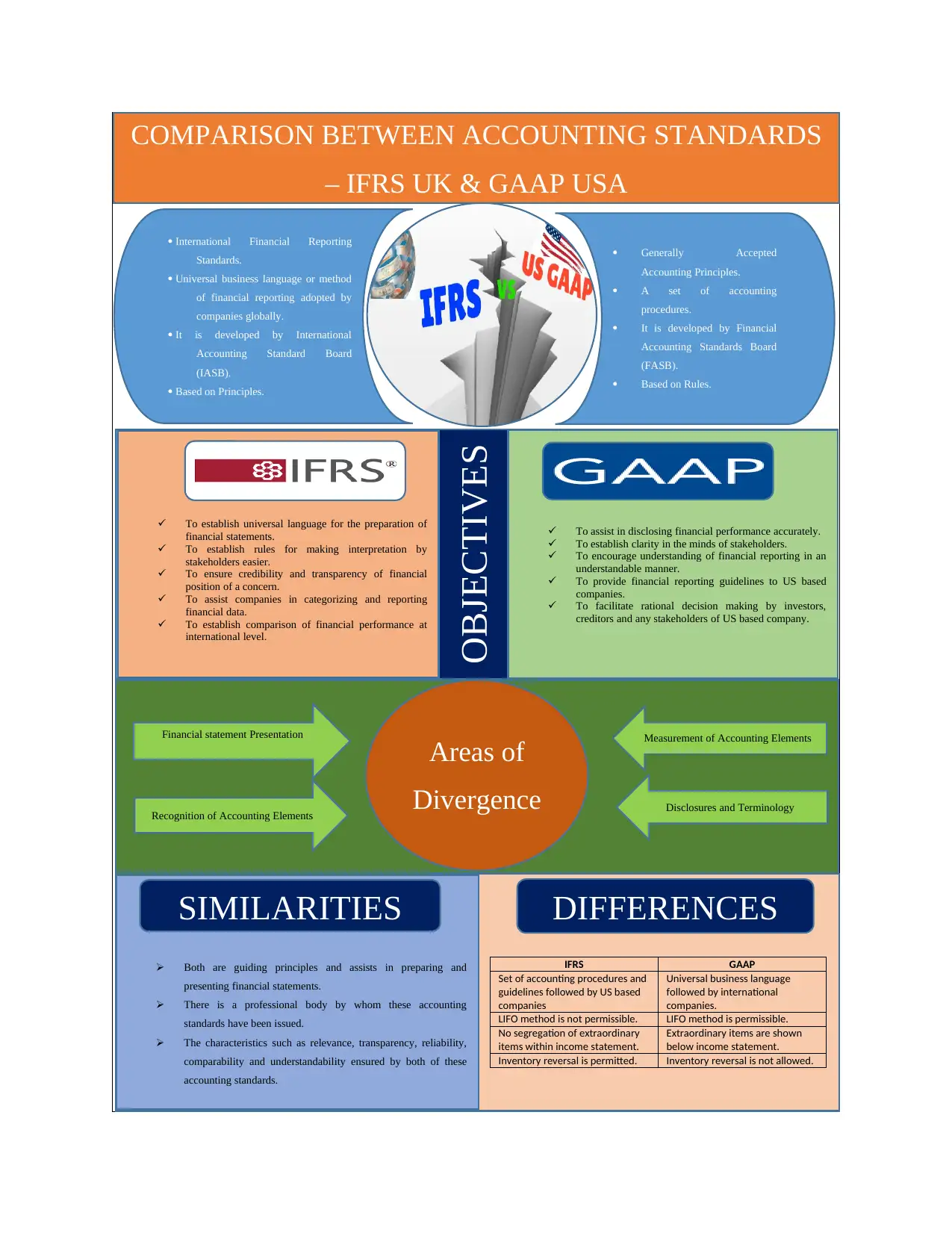
COMPARISON BETWEEN ACCOUNTING STANDARDS
– IFRS UK & GAAP USA
International Financial Reporting
Standards.
Universal business language or method
of financial reporting adopted by
companies globally.
It is developed by International
Accounting Standard Board
(IASB).
Based on Principles.
Generally Accepted
Accounting Principles.
A set of accounting
procedures.
It is developed by Financial
Accounting Standards Board
(FASB).
Based on Rules.
OBJECTIVES
To establish universal language for the preparation of
financial statements.
To establish rules for making interpretation by
stakeholders easier.
To ensure credibility and transparency of financial
position of a concern.
To assist companies in categorizing and reporting
financial data.
To establish comparison of financial performance at
international level.
To assist in disclosing financial performance accurately.
To establish clarity in the minds of stakeholders.
To encourage understanding of financial reporting in an
understandable manner.
To provide financial reporting guidelines to US based
companies.
To facilitate rational decision making by investors,
creditors and any stakeholders of US based company.
Areas of
Divergence
Financial statement Presentation
Recognition of Accounting Elements
Measurement of Accounting Elements
Disclosures and Terminology
Both are guiding principles and assists in preparing and
presenting financial statements.
There is a professional body by whom these accounting
standards have been issued.
The characteristics such as relevance, transparency, reliability,
comparability and understandability ensured by both of these
accounting standards.
IFRS GAAP
Set of accounting procedures and
guidelines followed by US based
companies
Universal business language
followed by international
companies.
LIFO method is not permissible. LIFO method is permissible.
No segregation of extraordinary
items within income statement.
Extraordinary items are shown
below income statement.
Inventory reversal is permitted. Inventory reversal is not allowed.
SIMILARITIES DIFFERENCES
– IFRS UK & GAAP USA
International Financial Reporting
Standards.
Universal business language or method
of financial reporting adopted by
companies globally.
It is developed by International
Accounting Standard Board
(IASB).
Based on Principles.
Generally Accepted
Accounting Principles.
A set of accounting
procedures.
It is developed by Financial
Accounting Standards Board
(FASB).
Based on Rules.
OBJECTIVES
To establish universal language for the preparation of
financial statements.
To establish rules for making interpretation by
stakeholders easier.
To ensure credibility and transparency of financial
position of a concern.
To assist companies in categorizing and reporting
financial data.
To establish comparison of financial performance at
international level.
To assist in disclosing financial performance accurately.
To establish clarity in the minds of stakeholders.
To encourage understanding of financial reporting in an
understandable manner.
To provide financial reporting guidelines to US based
companies.
To facilitate rational decision making by investors,
creditors and any stakeholders of US based company.
Areas of
Divergence
Financial statement Presentation
Recognition of Accounting Elements
Measurement of Accounting Elements
Disclosures and Terminology
Both are guiding principles and assists in preparing and
presenting financial statements.
There is a professional body by whom these accounting
standards have been issued.
The characteristics such as relevance, transparency, reliability,
comparability and understandability ensured by both of these
accounting standards.
IFRS GAAP
Set of accounting procedures and
guidelines followed by US based
companies
Universal business language
followed by international
companies.
LIFO method is not permissible. LIFO method is permissible.
No segregation of extraordinary
items within income statement.
Extraordinary items are shown
below income statement.
Inventory reversal is permitted. Inventory reversal is not allowed.
SIMILARITIES DIFFERENCES
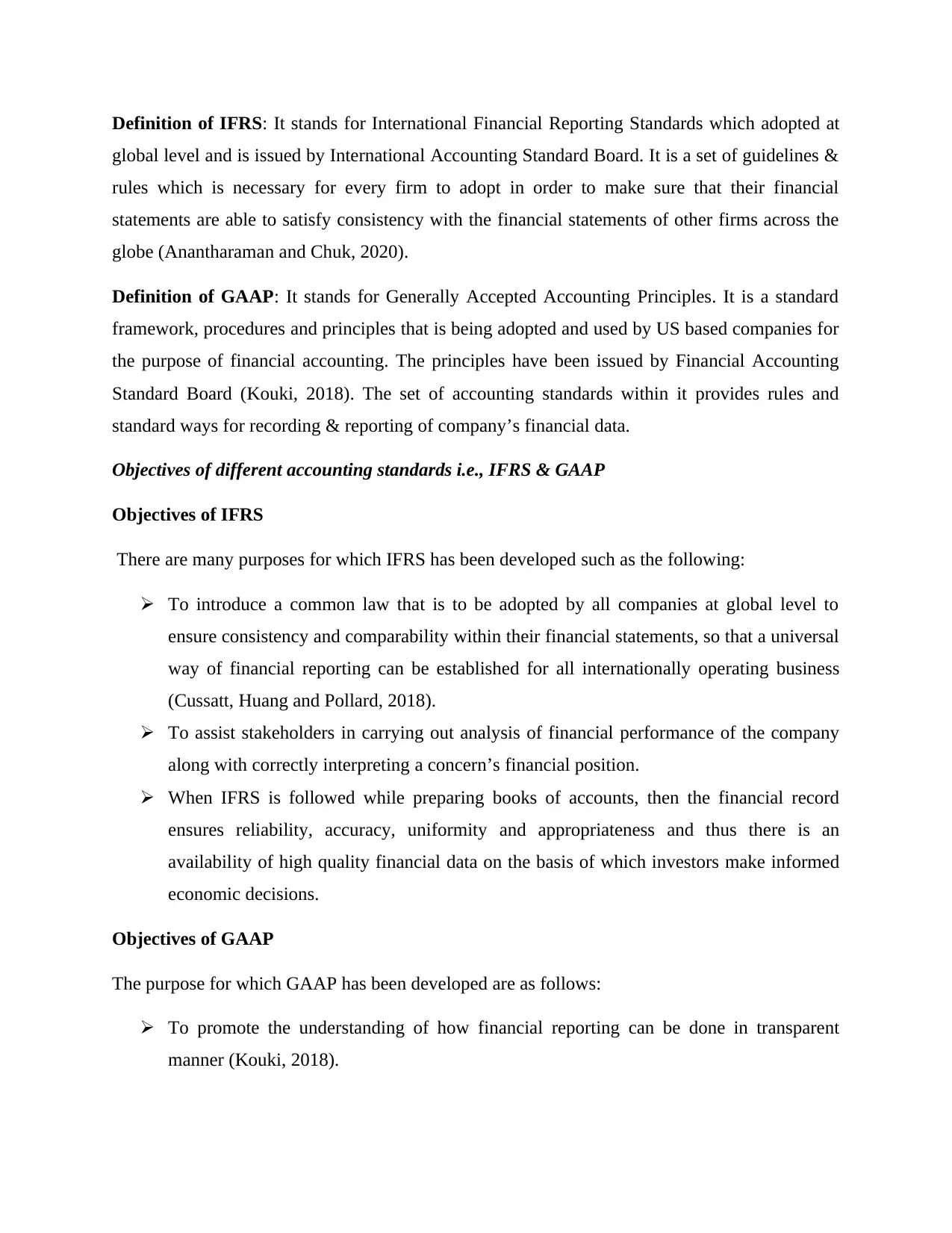
Definition of IFRS: It stands for International Financial Reporting Standards which adopted at
global level and is issued by International Accounting Standard Board. It is a set of guidelines &
rules which is necessary for every firm to adopt in order to make sure that their financial
statements are able to satisfy consistency with the financial statements of other firms across the
globe (Anantharaman and Chuk, 2020).
Definition of GAAP: It stands for Generally Accepted Accounting Principles. It is a standard
framework, procedures and principles that is being adopted and used by US based companies for
the purpose of financial accounting. The principles have been issued by Financial Accounting
Standard Board (Kouki, 2018). The set of accounting standards within it provides rules and
standard ways for recording & reporting of company’s financial data.
Objectives of different accounting standards i.e., IFRS & GAAP
Objectives of IFRS
There are many purposes for which IFRS has been developed such as the following:
To introduce a common law that is to be adopted by all companies at global level to
ensure consistency and comparability within their financial statements, so that a universal
way of financial reporting can be established for all internationally operating business
(Cussatt, Huang and Pollard, 2018).
To assist stakeholders in carrying out analysis of financial performance of the company
along with correctly interpreting a concern’s financial position.
When IFRS is followed while preparing books of accounts, then the financial record
ensures reliability, accuracy, uniformity and appropriateness and thus there is an
availability of high quality financial data on the basis of which investors make informed
economic decisions.
Objectives of GAAP
The purpose for which GAAP has been developed are as follows:
To promote the understanding of how financial reporting can be done in transparent
manner (Kouki, 2018).
global level and is issued by International Accounting Standard Board. It is a set of guidelines &
rules which is necessary for every firm to adopt in order to make sure that their financial
statements are able to satisfy consistency with the financial statements of other firms across the
globe (Anantharaman and Chuk, 2020).
Definition of GAAP: It stands for Generally Accepted Accounting Principles. It is a standard
framework, procedures and principles that is being adopted and used by US based companies for
the purpose of financial accounting. The principles have been issued by Financial Accounting
Standard Board (Kouki, 2018). The set of accounting standards within it provides rules and
standard ways for recording & reporting of company’s financial data.
Objectives of different accounting standards i.e., IFRS & GAAP
Objectives of IFRS
There are many purposes for which IFRS has been developed such as the following:
To introduce a common law that is to be adopted by all companies at global level to
ensure consistency and comparability within their financial statements, so that a universal
way of financial reporting can be established for all internationally operating business
(Cussatt, Huang and Pollard, 2018).
To assist stakeholders in carrying out analysis of financial performance of the company
along with correctly interpreting a concern’s financial position.
When IFRS is followed while preparing books of accounts, then the financial record
ensures reliability, accuracy, uniformity and appropriateness and thus there is an
availability of high quality financial data on the basis of which investors make informed
economic decisions.
Objectives of GAAP
The purpose for which GAAP has been developed are as follows:
To promote the understanding of how financial reporting can be done in transparent
manner (Kouki, 2018).
⊘ This is a preview!⊘
Do you want full access?
Subscribe today to unlock all pages.

Trusted by 1+ million students worldwide
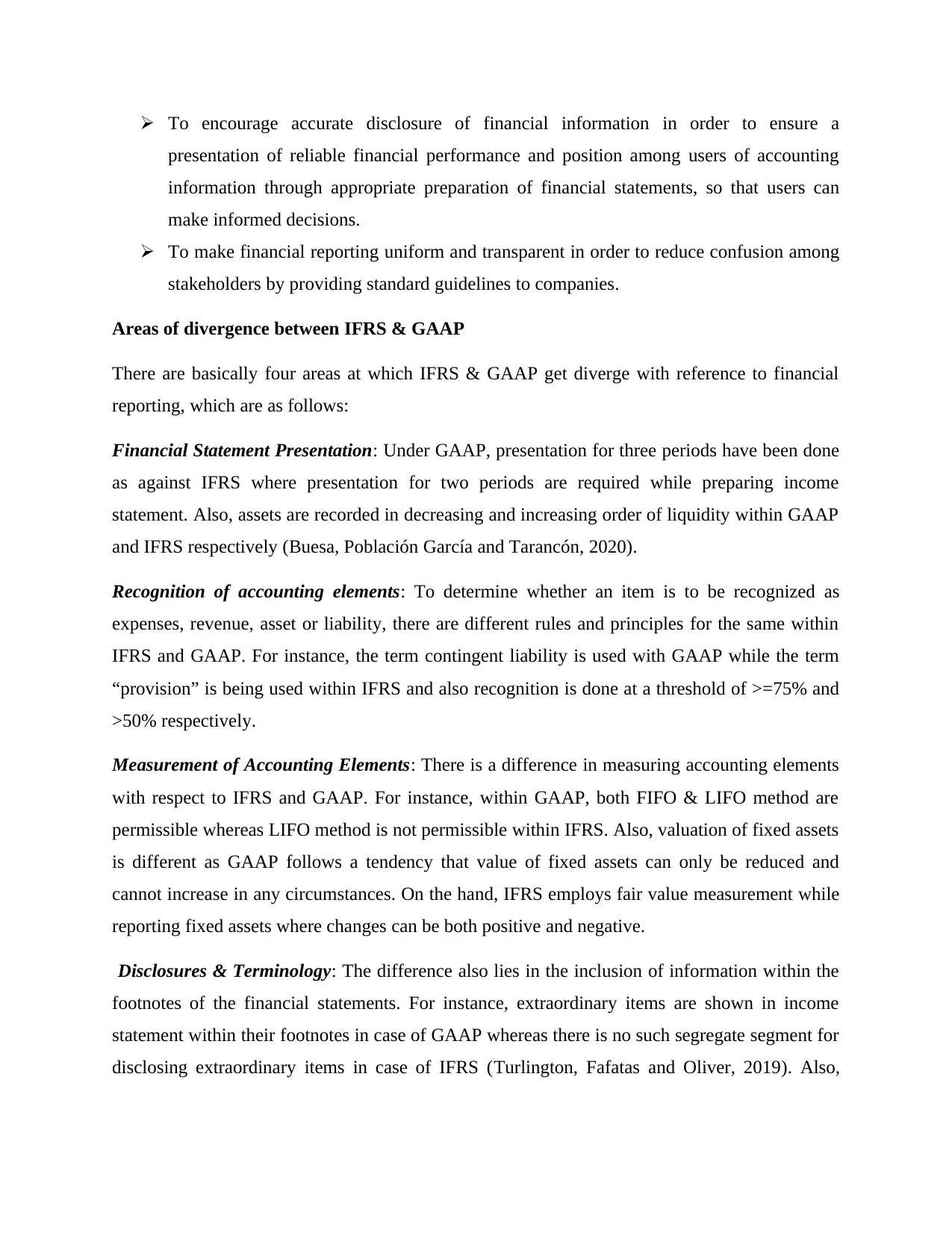
To encourage accurate disclosure of financial information in order to ensure a
presentation of reliable financial performance and position among users of accounting
information through appropriate preparation of financial statements, so that users can
make informed decisions.
To make financial reporting uniform and transparent in order to reduce confusion among
stakeholders by providing standard guidelines to companies.
Areas of divergence between IFRS & GAAP
There are basically four areas at which IFRS & GAAP get diverge with reference to financial
reporting, which are as follows:
Financial Statement Presentation: Under GAAP, presentation for three periods have been done
as against IFRS where presentation for two periods are required while preparing income
statement. Also, assets are recorded in decreasing and increasing order of liquidity within GAAP
and IFRS respectively (Buesa, Población García and Tarancón, 2020).
Recognition of accounting elements: To determine whether an item is to be recognized as
expenses, revenue, asset or liability, there are different rules and principles for the same within
IFRS and GAAP. For instance, the term contingent liability is used with GAAP while the term
“provision” is being used within IFRS and also recognition is done at a threshold of >=75% and
>50% respectively.
Measurement of Accounting Elements: There is a difference in measuring accounting elements
with respect to IFRS and GAAP. For instance, within GAAP, both FIFO & LIFO method are
permissible whereas LIFO method is not permissible within IFRS. Also, valuation of fixed assets
is different as GAAP follows a tendency that value of fixed assets can only be reduced and
cannot increase in any circumstances. On the hand, IFRS employs fair value measurement while
reporting fixed assets where changes can be both positive and negative.
Disclosures & Terminology: The difference also lies in the inclusion of information within the
footnotes of the financial statements. For instance, extraordinary items are shown in income
statement within their footnotes in case of GAAP whereas there is no such segregate segment for
disclosing extraordinary items in case of IFRS (Turlington, Fafatas and Oliver, 2019). Also,
presentation of reliable financial performance and position among users of accounting
information through appropriate preparation of financial statements, so that users can
make informed decisions.
To make financial reporting uniform and transparent in order to reduce confusion among
stakeholders by providing standard guidelines to companies.
Areas of divergence between IFRS & GAAP
There are basically four areas at which IFRS & GAAP get diverge with reference to financial
reporting, which are as follows:
Financial Statement Presentation: Under GAAP, presentation for three periods have been done
as against IFRS where presentation for two periods are required while preparing income
statement. Also, assets are recorded in decreasing and increasing order of liquidity within GAAP
and IFRS respectively (Buesa, Población García and Tarancón, 2020).
Recognition of accounting elements: To determine whether an item is to be recognized as
expenses, revenue, asset or liability, there are different rules and principles for the same within
IFRS and GAAP. For instance, the term contingent liability is used with GAAP while the term
“provision” is being used within IFRS and also recognition is done at a threshold of >=75% and
>50% respectively.
Measurement of Accounting Elements: There is a difference in measuring accounting elements
with respect to IFRS and GAAP. For instance, within GAAP, both FIFO & LIFO method are
permissible whereas LIFO method is not permissible within IFRS. Also, valuation of fixed assets
is different as GAAP follows a tendency that value of fixed assets can only be reduced and
cannot increase in any circumstances. On the hand, IFRS employs fair value measurement while
reporting fixed assets where changes can be both positive and negative.
Disclosures & Terminology: The difference also lies in the inclusion of information within the
footnotes of the financial statements. For instance, extraordinary items are shown in income
statement within their footnotes in case of GAAP whereas there is no such segregate segment for
disclosing extraordinary items in case of IFRS (Turlington, Fafatas and Oliver, 2019). Also,
Paraphrase This Document
Need a fresh take? Get an instant paraphrase of this document with our AI Paraphraser
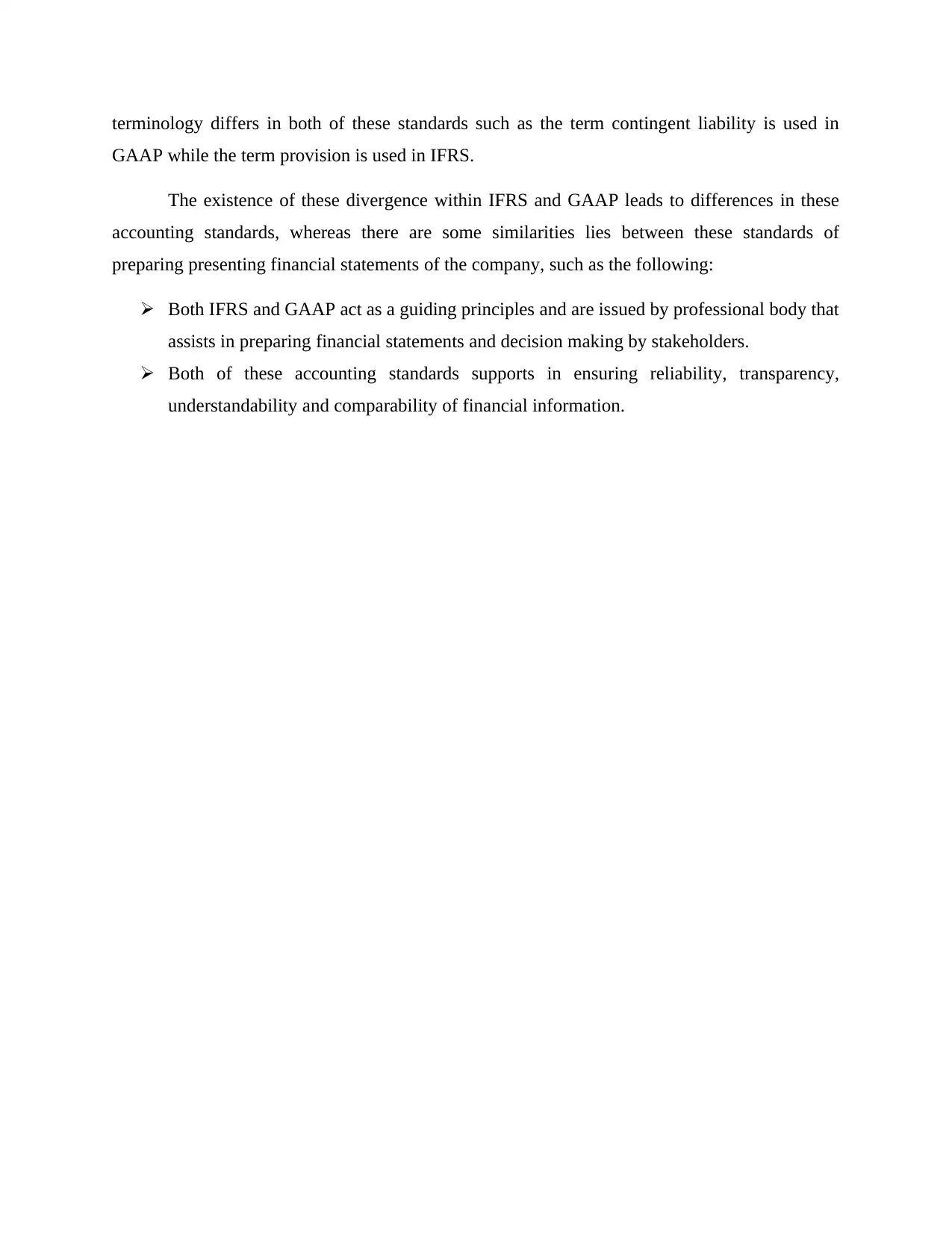
terminology differs in both of these standards such as the term contingent liability is used in
GAAP while the term provision is used in IFRS.
The existence of these divergence within IFRS and GAAP leads to differences in these
accounting standards, whereas there are some similarities lies between these standards of
preparing presenting financial statements of the company, such as the following:
Both IFRS and GAAP act as a guiding principles and are issued by professional body that
assists in preparing financial statements and decision making by stakeholders.
Both of these accounting standards supports in ensuring reliability, transparency,
understandability and comparability of financial information.
GAAP while the term provision is used in IFRS.
The existence of these divergence within IFRS and GAAP leads to differences in these
accounting standards, whereas there are some similarities lies between these standards of
preparing presenting financial statements of the company, such as the following:
Both IFRS and GAAP act as a guiding principles and are issued by professional body that
assists in preparing financial statements and decision making by stakeholders.
Both of these accounting standards supports in ensuring reliability, transparency,
understandability and comparability of financial information.
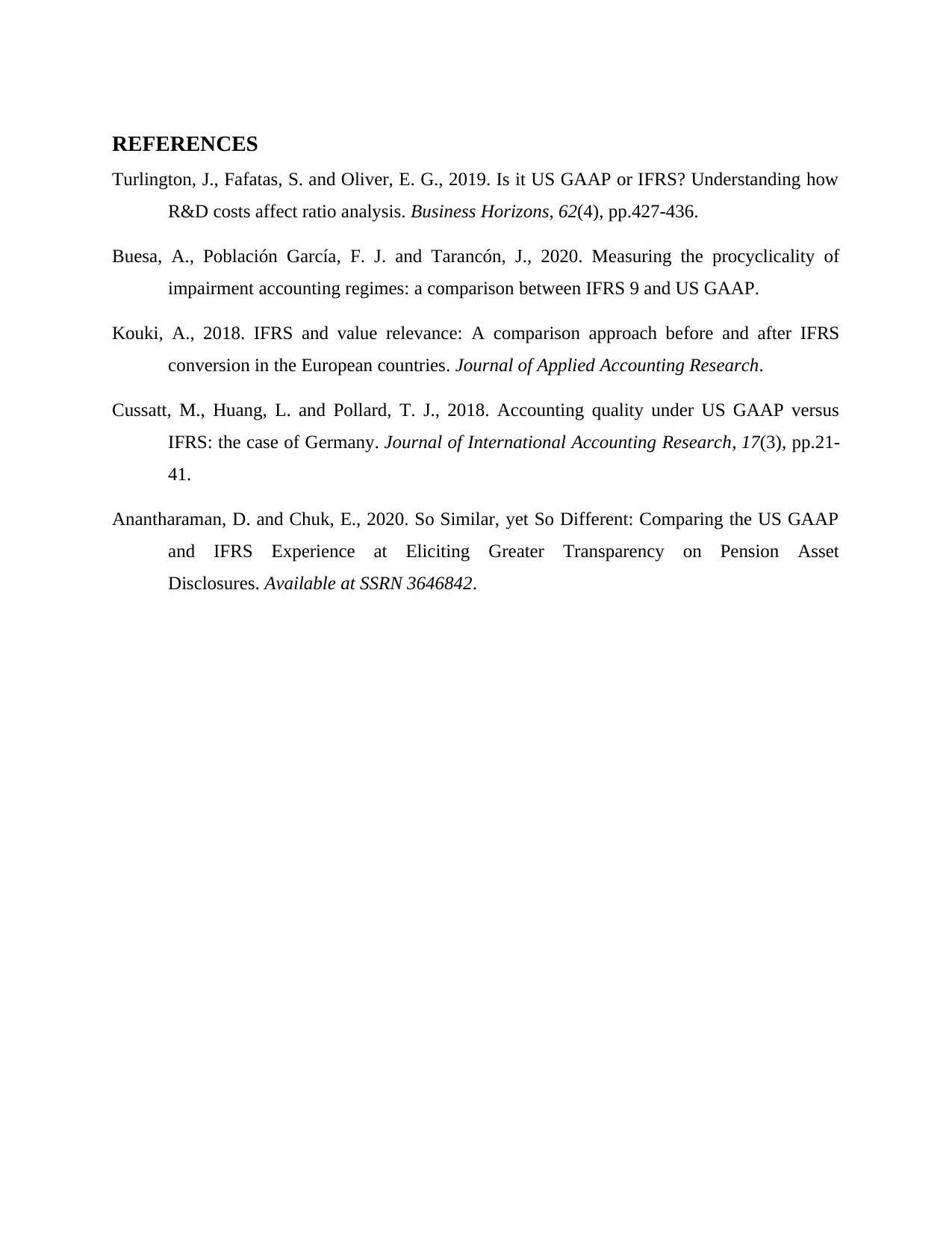
REFERENCES
Turlington, J., Fafatas, S. and Oliver, E. G., 2019. Is it US GAAP or IFRS? Understanding how
R&D costs affect ratio analysis. Business Horizons, 62(4), pp.427-436.
Buesa, A., Población García, F. J. and Tarancón, J., 2020. Measuring the procyclicality of
impairment accounting regimes: a comparison between IFRS 9 and US GAAP.
Kouki, A., 2018. IFRS and value relevance: A comparison approach before and after IFRS
conversion in the European countries. Journal of Applied Accounting Research.
Cussatt, M., Huang, L. and Pollard, T. J., 2018. Accounting quality under US GAAP versus
IFRS: the case of Germany. Journal of International Accounting Research, 17(3), pp.21-
41.
Anantharaman, D. and Chuk, E., 2020. So Similar, yet So Different: Comparing the US GAAP
and IFRS Experience at Eliciting Greater Transparency on Pension Asset
Disclosures. Available at SSRN 3646842.
Turlington, J., Fafatas, S. and Oliver, E. G., 2019. Is it US GAAP or IFRS? Understanding how
R&D costs affect ratio analysis. Business Horizons, 62(4), pp.427-436.
Buesa, A., Población García, F. J. and Tarancón, J., 2020. Measuring the procyclicality of
impairment accounting regimes: a comparison between IFRS 9 and US GAAP.
Kouki, A., 2018. IFRS and value relevance: A comparison approach before and after IFRS
conversion in the European countries. Journal of Applied Accounting Research.
Cussatt, M., Huang, L. and Pollard, T. J., 2018. Accounting quality under US GAAP versus
IFRS: the case of Germany. Journal of International Accounting Research, 17(3), pp.21-
41.
Anantharaman, D. and Chuk, E., 2020. So Similar, yet So Different: Comparing the US GAAP
and IFRS Experience at Eliciting Greater Transparency on Pension Asset
Disclosures. Available at SSRN 3646842.
⊘ This is a preview!⊘
Do you want full access?
Subscribe today to unlock all pages.

Trusted by 1+ million students worldwide
1 out of 6
Related Documents
Your All-in-One AI-Powered Toolkit for Academic Success.
+13062052269
info@desklib.com
Available 24*7 on WhatsApp / Email
![[object Object]](/_next/static/media/star-bottom.7253800d.svg)
Unlock your academic potential
Copyright © 2020–2025 A2Z Services. All Rights Reserved. Developed and managed by ZUCOL.





